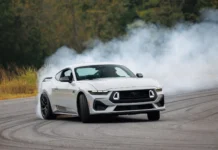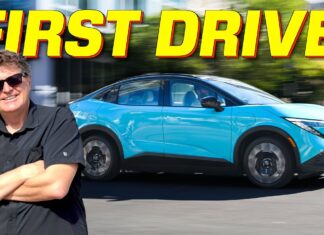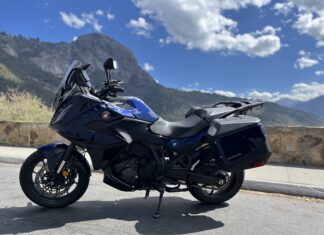 According to Ford, “Sixty percent of Americans shopping for a vehicle this year will look at either a mid-size car or small sport utility vehicle.” Couple that statistic with a sensitivity to increasing gas prices and it becomes clear why America’s longest running car manufacturer is hedging bets that the 2013 Ford Escape will be a hit with consumers.
According to Ford, “Sixty percent of Americans shopping for a vehicle this year will look at either a mid-size car or small sport utility vehicle.” Couple that statistic with a sensitivity to increasing gas prices and it becomes clear why America’s longest running car manufacturer is hedging bets that the 2013 Ford Escape will be a hit with consumers.
So let’s get right to it…
Powertrain, Suspension & Steering
With an eye towards better fuel economy, buyers have three DOHC (dual overhead cam) inline-four engines to choose from in the redesigned Escape. A 2.5-liter (168 horsepower and 170 lb.-ft. of torque) for front-wheel drive-only models, a 1.6-liter (178 horsepower and 184 lb.-ft. of torque) for available four wheel drive models, and a 2.0-liter (240 horsepower and 270 lb.-ft. of torque) also for available four wheel drive models. The three engines permit 1,500-lbs., 2,000-lbs., and 3,500-lbs. of towing capability, respectively. If you’re an off-road enthusiast who loves to row through the gears, you’ll have to shop a different brand as all engines come mated to a six-speed automatic. But let’s be honest, few people will use an Escape for weekend mud bogging excursions.

To smooth out the bumps, all models come with an independent MacPherson strut suspension in the front and Ford’s Control Blade – basically a solid stabilizer bar – in the rear. Rack-and-pinion steering with electric power assist makes navigating parking lots and the morning commute almost effortless.
To slow things down, all models come standard with four-channel, anti-lock disc brakes and electronic stability control. In the rear, 11-inch solid disc rotors come on all trims, paired with 11.8-inch vented discs in the front, or 12.6-inch vented discs on larger wheeled models.
With no shortage of competition (Honda CR-V, Mazda CX-5, Volkswagen Tiguan, Hyundai Tucson) in an increasingly crowded segment, the question, “what makes the Escape different from the competition?” begs to be asked. The answer is easy – the gadgets.
In-Car Tech
Three tech-filled features that have the potential to raise the bar of competition include Ford’s proprietary MyKey key fob, hands-free liftgate, and ear-busting Sony audio system.
The MyKey key fob looks like any other pocket ornament from a late model car, however its capabilities outclass even the most expensive of premium brand models from the likes of Mercedes or BMW due to its family-conscious features. Each fob is capable of personalized settings, which can be programmed by the owner. For instance, a parent could restrict the vehicle’s top speed to a specific velocity (say, 65 MPH) to aid their teenager in responsible highway driving. Additionally, the parent could limit the stereo’s system volume level to 44% of maximum volume. If that weren’t enough safety oversight, a chime will sound inside the car and mute the stereo volume until all occupied front seats are buckled up.
Ford’s hands-free lift gate technology isn’t new to the auto marketplace (BMW introduced it late last year with the all-new 3-Series sedan). However, the availability of such a slick feature is a first in the Escape’s more affordable segment. To open the lift gate, simply place your foot underneath the rear bumper (like you are kicking a soccer ball) – the gate magically opens. You don’t have to worry about thieves gaining access to your vehicle as the feature only works if the key fob is within an arm’s length of the car.
The result of a deal with Sony to supply its highest end audio system, the Escape’s, 10-speaker (including subwoofer) entertainment system does something usually only seen on pricey aftermarket head units – it remembers the music you like and makes it available for purchase via the Web. Here’s how it works: With your iPod connected to the entertainment system via the USB port, the unit is equipped with HD radio which allows you to listen to FM stations at a CD-quality audio level. HD technology is digital and as a result doesn’t just receive audio signals, but data signals (such as song title/artist information) as well. Like the song you are listening to on your favorite radio station? As long as your Apple iPod is connected to the USB port in the car, you just have to tap a button on the unit and your iPod will tag the title/artist information. The next time you sync your iPod with iTunes, you’ll be prompted to purchase the song.
You Pay For What You Get
From its Louisville, Kentucky manufacturing plant, there are four trim levels to satisfy most budgets and feature needs. Starting with the base S model ($22,470), the light hauler comes standard with the 2.5-liter engine mentioned earlier, 17” steel wheels, cloth seats and Ford’s MyKey key fob system. The SE ($25,070) adds a 1.6-liter direct-injected turbo engine (EcoBoost), dual chrome exhaust tips, fog lamps, 17” alloy wheels, keyless-entry keypad, voice activated infotainment system (SYNC) and Sirius satellite radio. The SEL ($27,870) piggybacks the SE trim level with heated mirrors, leather-trimmed and heated power front seats, 18” alloy wheels, and dual zone temperature control. The most expensive Titanium trim level ($30,370) replaces the 1.6-liter engine with a 2.0-liter direct-injected turbo (EcoBoost), 19” alloy wheels, keyless push-button start, hands free lift gate, upgraded audio system, roof rack, rear parking sensors and HID (high intensity discharge) headlamps. There is an $825 destination charge on all trim levels.
On the Road
To sum it up, the new Escape borrows the same design language from the recently redesigned Ford Focus, albeit with a little more steroids pumped in. The wheel wells swell more and the high shoulder line gives the vehicle a more aggressive look. Ample uses of bright work, a trapezoidal grill and a sleek, yet long windshield add to the sporty looking nature of this CUV.
Pointing the test vehicle 70-miles away from San Francisco towards the Bodega Harbour Country Club where a lunch break awaited, I was immediately impressed with the 2.0-liter EcoBoost I-4 engine’s pep. I found this out in the most desperate of circumstances as I tried to merge onto I-580 towards San Rafael. A large 18-wheeler descended upon my port side and the merge lane was quickly ending. I floored it, and was amazed how quickly the SUV jumped from 60 to 80-MPH, whisking me safely ahead of the 20,000 lb. moving ramrod. No turbo-lag here.
Consequently, I found out how capable the larger, 12.6-inch disc brakes were only seconds later when a pimple-faced teen in a white, ’96 Honda Civic cut directly in front of me, forcing a pedal-mashing party in the Escape’s foot well. I think it’s safe to say the brakes on the Escape do a great job in the real world as the car emerged unscathed.
Continuing towards the foothills surrounding Nicasio Valley, the almost compact sedan–like wheelbase of 105.9-inches proved a pleasant ride on long stretches of highway before entering twisty country roads. Steering proved accurate and body roll was minimal when compared to it’s larger sibling, the Explorer. There was a slight amount of wind noise in the A-pillars, along with a very low whirr sound from the tires at highway speeds, but nothing that would become fatiguing on cross state family trips. The fitment of interior pieces was well executed, however there were some niggling points in the finish department that stuck out.
Even though the steering wheel comes trimmed in leather, it had a very cheap quality to it. Perhaps it was the amount of spongy padding encased by the thin-feeling hide. At any rate, for $30k-plus, I’d think consumers would want something that doesn’t feel like a Nerf ball.
The doorsills and dash have that same spongy feeling as well, except instead of being wrapped in leather, they have a vinyl surface adhered to foam backing. In the long run, these aren’t deal breakers on the smallish ‘ute, but it’s little details like this which add a premium character, even if the vehicle sells for an economical price.
The updated MyFord Touch navigation unit with Microsoft Sync assisted finding the lunch/turnaround point at the country club for my test jaunt, audibly announcing turns and quickly rerouting me when I missed an intersection. The screen is large, and bright, but some of the more heavily used soft keys (i.e. destination) are small and located in the top right corner of the screen. At 5’-8”, I may not have the longest arm span, but I found myself having to divert my attention from the task of driving to lean forward and henpeck the smallish icons. Did someone say, “driver distraction?”
After downing a few tasty morsels at Bodega Harbour’s Blue Water Bistro, I decided to snap a few photos of the gorgeous view atop Bodega Bay. This activity also gave me an excuse to test out the hands-free liftgate feature in order to access my camera gear. With a simple kicking motion, the door magically opened and I was quickly able to pull out my gear bag from the 34.3-cubic inch storage area. I didn’t collapse the second row seats, but I’ll take Ford’s word that their fold-flat feature gulps down 68.1-cubic inches of cargo. The DIY’er in me could find that feature addictive for Home Depot runs on Saturday mornings.
As I made my way to the Argonaut Hotel back in San Francisco, I cranked the volume on the 390-watt Sony sound system. Shortly thereafter, a full thumb-drumming solo on the steering wheel ensued as the powerful amp belted out Guns ‘N Roses’, Paradise City. The steering wheel may feel cheap, but that can’t be said about the quality of the entertainment system’s sound. Highs are distortion free, and the lows sounded like the bass drum was being struck right next to me in the passenger seat. A few blocks before arriving at the hotel, I brought the concert volume down to a low roar while responding to orders from the navigation system.
Pulling up to the hotel, I pressed the Start/Stop Engine button and emerged from the well-bolstered leather seats with nary an ache on my body nor a complaint from my ears. After 140-miles of varied country, city and highway miles, the Escape proved to be comfortable, pleasant sounding and easy on the eyes. Now if we could just fix that darn steering wheel…
Pros
- Premium features at a not-so premium price
- Fuel-sipping engines (The 1.6L EcoBoost gets an EPA rating of 23/city, 33/highway)
- Lots of tech options
Cons
- Spongy steering wheel
- Overabundance of cheap-feeling surfaces
- Button-challenged navigation unit
On the TFLcar.com recommendation scale of:
– Buy it
– Lease it
– Rent it or
-Forget it
I recommend that you Buy it!
 Ryan’s passion for automobiles began at age eight when his father brought home the quintessential sports car: A Guards Red, 1974 Porsche 911 Targa. Ever since, his free time has been consumed with following the latest developments of the automotive industry.
Ryan’s passion for automobiles began at age eight when his father brought home the quintessential sports car: A Guards Red, 1974 Porsche 911 Targa. Ever since, his free time has been consumed with following the latest developments of the automotive industry.



























